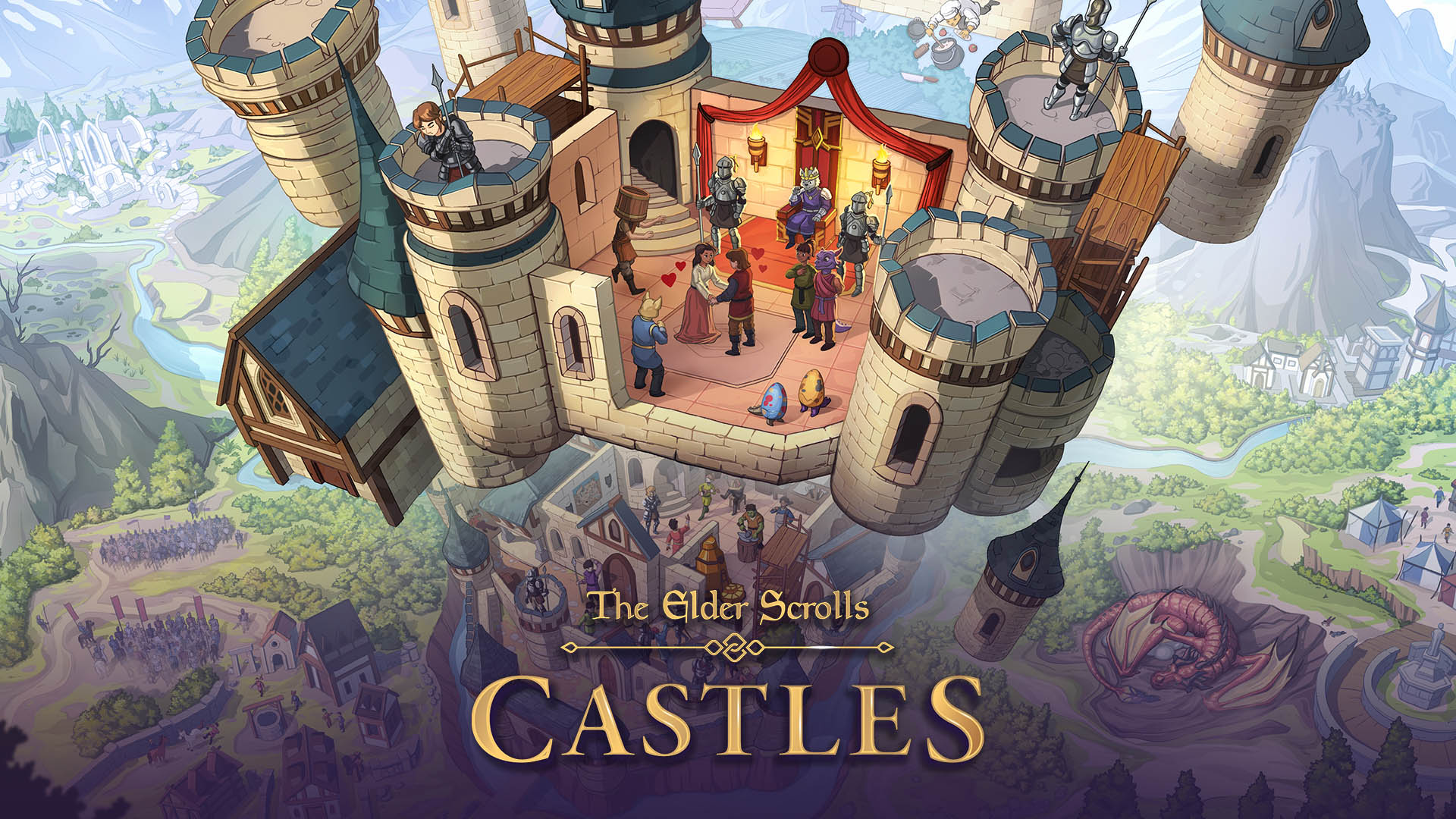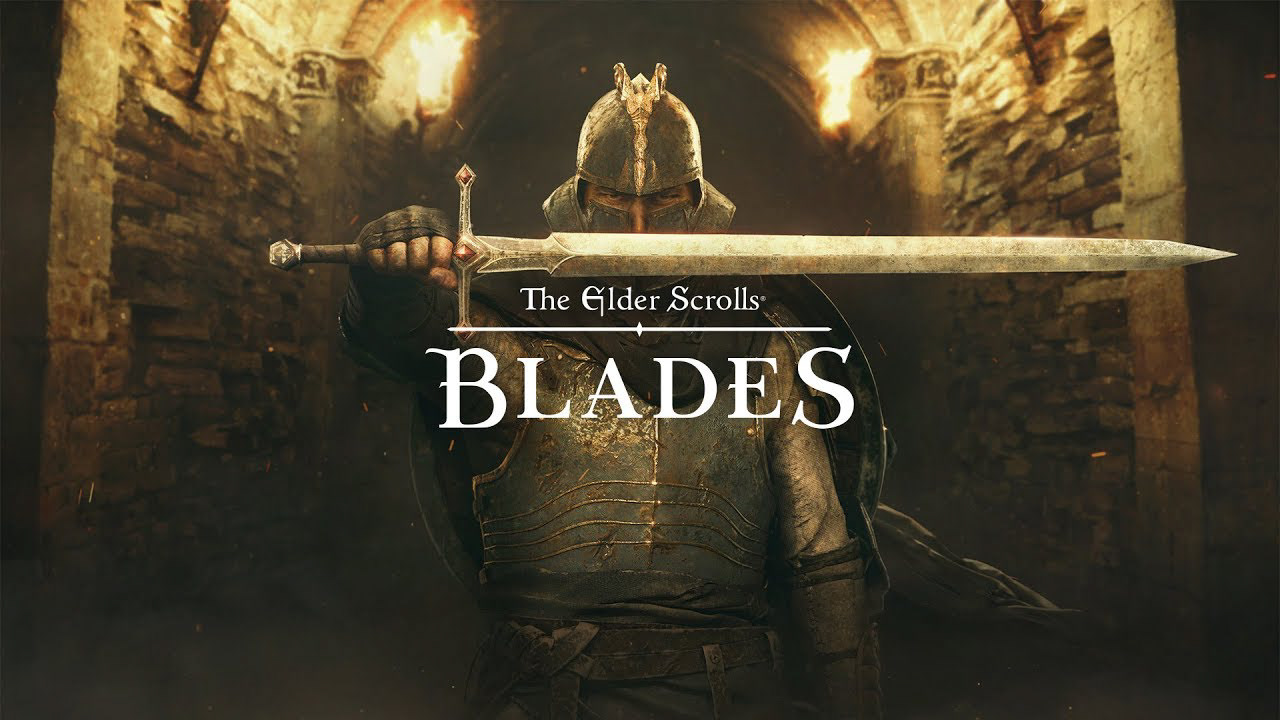Players Make All Rolls

This is a rule adopted in my D&D campaigns where the GM makes as few rolls as possible. Players are the ones in command of their destiny and randomness, making both attacks and defenses rolls. They also roll to strike enemies' spell defenses, instead of the GM rolling for saving throws.
Player Defense
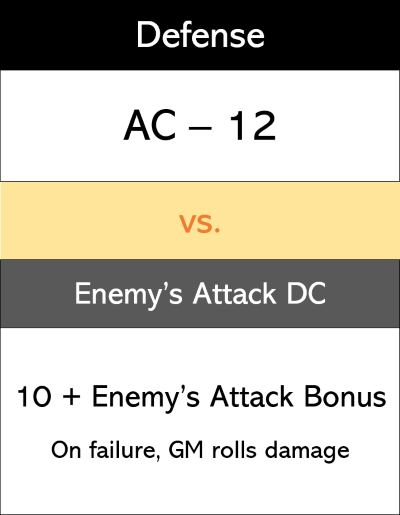
Instead of the GM rolling for each and every NPC attack, it is the players who roll to defend against an NPC's attack bonuses.
Defense Modifier
Each player create a new field for a modifier called "Defense". The value is always AC - 12. Examples:
- A fighter has AC of 20 with his armor and shield. His Defense is +8 (20-12=8).
- A mage has AC of 12 and casts Shield for this turn, gaining +5 AC. His Defense is +5 (12+5-12=5)
- A cleric has an AC of 19 and casts Shield of Faith for this combat, gaining +2 AC. Defense is +9 (19+2-12=9)
Enemy's Attack DC
Whenever the GM decides an NPC attacks, she calculates a DC as in 10 + the Bonus of the upcoming attack. Examples:
- A goblin has a +3 to hit bonus with a dagger. The DC for his attack is 13 (10+3=13)
- A witch slings a Firebolt with a +6 spell attack bonus. The DC for her attack is 16 (10+6=16)
- A bandit leader shoots two longbow attacks at +7 each. The DC for both attacks are 17 (10+7=17)
Defense Roll!
Finally, the player rolls 1d20 + Defense modifier each time the GM decides that an NPC attacks them, and has to roll equal or more than the enemy's Attack DC. (Much like a Skill check.) Examples:
- A fighter with Defense +8 is being attacked by the goblin with +3 to hit. She rolls 11 in a d20, summing 11+8=19, which is higher than the goblin's attack DC of 13. The goblin misses.
- A mage with Defense +5 is being attacked by a sorcerer slinging a Firebolt with spell attack +6. He rolls 7 in a d20, summing 7+5=12, which is lower than the witch's attack DC of 16. The witch hits!
- A cleric with Defense +9 is being attacked twice by a bandit leader with +7 to hit. She rolls a d20 twice for a 4 and a 14, summing two defenses of 4+9=13 and 14+9=23. Since the bandit leader attack DC is 17 the cleric suffers the damage from the first attack but defends against the second!
1 in d20
A d20 roll of 1 for Defense corresponds to the enemy rolling a Critical Damage! The player receives double the damage roll as if the GM rolled a 20 for the enemy attack.
Player Spell Strike
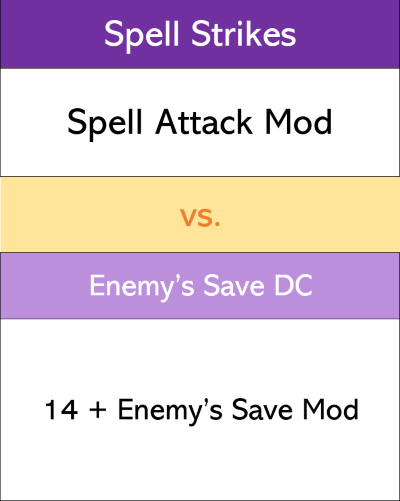
Spell Strike Modifier = Spell Attack
This one is easy: players only need the same Spell Attack modifier they already use for spells like Eldritch Blast and Chilling Touch. The only difference is that this "spell strike" roll does not count as an attack - the player is not trying to overcome the target's AC, but other forms of defense (reflexes, willpower, etc).
Enemy's Save DC
This depends on the saving throw of the spell. The GM consults the saving throw modifier to resist the spell and calculates the DC as 14 + enemy's Save mod. Examples:
- The player casts Burning Hands against a goblin with +1 Dexterity mod. For this spell, the Save DC is 15 (14+1=15)
- The player casts Toll the Dead against a witch with +5 Wisdom mod. For this spell, the Save DC is 19 (14+5=19)
- The player casts Vicious Mockery against a bandit leader with -1 Intelligence mod. For this spell, the Save DC is 13 (14-1=13)
Spell Strike Roll!
Finally, the player rolls 1d20 + Spell Attack, and a result equal or higher of the enemy's Save DC means the spell has its full effect. (Again, much like a Skill check.) Otherwise, the spell is either negated or has a partial effect. Examples:
- A player with Spell Attack +4 casts Burning Hands against a goblin with +1 Dexterity mod. She rolls 11 in a d20, summing 11+4=15, which is equal to the goblin's save DC of 15. The goblin fails his save and the deals full fire damage!
- A player with Spell Attack +6 casts Toll the Dead against a witch with +5 Wisdom mod. He rolls 3 in a d20, summing 3+6=9, which is less than the witch's save DC of 19. The witch succeeds in saving and the player deals no damage.
- A player with Spell Attack +5 casts Vicious Mockery against a bandit leader with -1 Intelligence mod. She rolls 15 in a d20, summing 15+5=20, which is higher than the bandits's save DC of 13. The bandit fails and suffers the full psychic damage.
GM rolls for damage
In any of these cases, the GM still rolls for damage. She may also opt to use "average damage" from the NPC stat block.
Invert Advantages <-> Disadvantages
Both for Defense rolls and Spell Strikes, any condition that would grant Advantage to the enemy is translated into Disadvantage to the player. And vice-versa: a Disadvantage for the enemy would become an Advantage in the player roll.
NPC Initiative is Passive
NPCs always have an initiative value of 10 + Initiative modifier. The GM doesn't roll for this.
Skill Contests
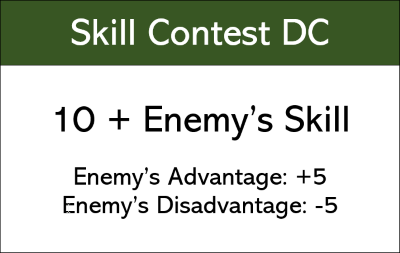
- A player with Deception +5 is attempting to fool an NPC with Insight +3. She rolls the Deception check against a DC of 10+3=13
- A player with Stealth +4 is attempting to hide in the shadows from a NPC with Perception +5. He rolls the Stealth check against a DC of 10+5=15
If the enemy would have Advantage, the DC for the player to roll against increase by +5. If the enemy would have Disadvantage, the DC for the player to roll against decreases by -5.
